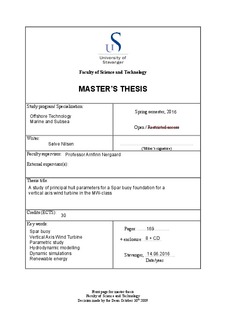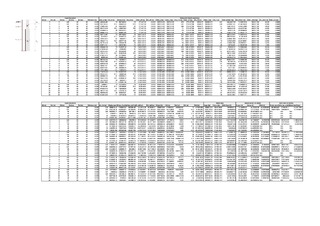| dc.description.abstract | This thesis analyses a vertical axis wind turbine (VAWT) in the MW-class used in relation with a floating
Spar buoy. The objective was to study the effect of varying principal hull parameters including diameter
and draft on the overall system’s hydrostatic and hydrodynamic performance. First, a spreadsheet was
constructed, containing certain engineering simplifications to evaluate a number of floating geometries
with varying drafts and diameters in an effective manner. These results formed the basis for selecting
three potential floaters to be evaluated in comprehensive hydrodynamic simulations. However,
frequency dependent added mass and damping matrices, displacement RAOs and load RAOs in the six
degrees of freedom (DOFs) had to be established prior to running the simulations. The software HydroD
was used for this purpose, which utilizes three-dimensional potential theory to calculate the
aforementioned parameters.
The parameters metacentric height, natural periods and static inclination angles were evaluated in the
spreadsheet calculations to analyze the effect of varying principal hull parameters on the system’s
hydrostatic performance. The evaluated floater geometries were established by varying the draft in
increments of 25 meters and calculate the needed diameter to gain a displacement of 5300 tons.
A new vessel was generated in OrcaFlex using the output gained from the HydroD analysis, where a total
of two environmental conditions were evaluated. The first, referred to as EC 1, represented an
operational condition at rated power output, while the second, referred to as EC 2, represented a full
storm scenario. The sea state was modelled an irregular wave train generated form a JONSWAP wave
spectrum with peakadness factor of 3.3, while the wind was modelled as a point load acting at the center
of the rotor blades. The simplified wind environment is a rather coarse approximation, but necessary
nonetheless, as time was rather spent on obtaining an accurate hydrodynamic model. Performance
parameters such as motions in the six DOFs, minimum freeboard and air-gap, effective tension in the
mooring lines and arc-length to touchdown point were evaluated to analyze the effect of varying
principal hull parameters on the system’s hydrodynamic performance.
The results from the spreadsheet calculations revealed that a floater comprising of a higher draft and
lower diameter features a higher metacentric height due to an overall greater rise in ̅𝐾��������̅̅𝐵��������̅ compared to
the rise in ̅𝐾��������̅̅𝐺��������̅ associated with such a geometry. Since the studied floaters featured similar
displacements, i.e. similar buoyancy force, the high draft and low diameter floaters also illustrated more
favorable static inclination angles, as the increased ̅𝐺��������̅̅𝑀��������̅̅ led to a greater arm in the up-righting moment.
Furthermore, all studied geometries featured suitable natural periods to avoid resonance motions with
first-order wave effects.
The dynamic simulation indicated that a floater comprising of a higher draft and lower diameter floater
obtains the most favorable motion characteristic in surge, sway, heave, roll and pitch. The reduced
surge, sway and heave translations were related to a reduced total force, i.e. force that gives net
motions, in these DOF caused by the reduced diameter. The reduced roll and pitch motions were related
to the increased up-righting moment due to the greater metacentric height associated with a long and
slender floater. However, some cost considerations based on intuitive relations revealed that a higher
draft would most probably lead to a more expensive floating system. Furthermore, a high draft may
limit the number of operation sites suitable in accommodating the turbine system, as the site needs to
feature sufficient depth to facilitate the draft and the mooring lines used for station keeping purposes.
It is therefore believed that the optimum principal hull parameters combination will be a compromise
of sufficient stability, cost and depth at location the turbine shall operate. | nb_NO |


